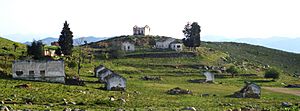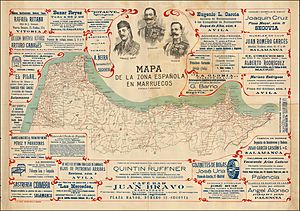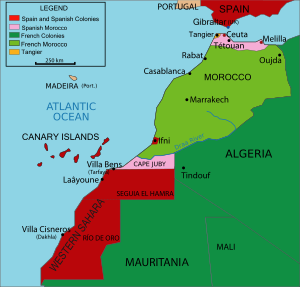Spanish protectorate in Morocco facts for kids
Quick facts for kids
Spanish Protectorate in Morocco
|
|||||||||
|---|---|---|---|---|---|---|---|---|---|
| 1912–1956 | |||||||||

Map of the protectorate's northern zone (Spanish Morocco proper) and southern zone (Cape Juby)
|
|||||||||

Map of the northern zone in 1956
|
|||||||||
| Status | Protectorate | ||||||||
| Capital | Tetuán | ||||||||
| Common languages | Spanish (official) Berber Arabic Tetuani or Haketia |
||||||||
| Religion | Islam (majority) Catholicism Judaism |
||||||||
| Government | Absolute monarchy (under protectorate) |
||||||||
| Sultan | |||||||||
|
• 1912–1927
|
Yusef | ||||||||
|
• 1927–1956
|
Mohammed V | ||||||||
| High Commissioner | |||||||||
|
• 1913 (first)
|
Felipe Alfau Mendoza | ||||||||
|
• 1951–1956 (last)
|
Rafael García Valiño | ||||||||
| Historical era | Interwar period | ||||||||
|
• Treaty of Madrid
|
27 November 1912 | ||||||||
|
• Rif War
|
June 1921 – May 1926 | ||||||||
| July 1936 | |||||||||
|
• Occupation of Tangier
|
June 1940 – October 1945 | ||||||||
|
• Retroceded to Morocco
|
7 April 1956 | ||||||||
| Currency | Spanish peseta | ||||||||
|
|||||||||
The Spanish protectorate in Morocco was a territory in Morocco that was controlled by Spain from 1912 to 1956. It was created by a treaty between France and Spain on November 27, 1912.
This protectorate had two main parts. There was a northern strip along the Mediterranean Sea and the Strait of Gibraltar. The other part was in the south, around Cape Juby, near the Spanish Sahara. The northern part became part of independent Morocco on April 7, 1956. This happened shortly after France also gave up its control over its part of Morocco.
Spain gave up its southern zone later, on April 1, 1958, after a short conflict called the Ifni War. The city of Tangier was not part of the Spanish protectorate. Instead, it had a special international status, meaning it was controlled by several countries.
France had already taken control of most of Morocco and managed its foreign affairs since March 30, 1912. This gave France the power to let Spain control a part of the country. The Spanish zone was about 20,948 square kilometers. This is about 4.69% of what modern-day Morocco is today.
Contents
History of the Spanish Protectorate
Why Spain Became Involved
At a time when many European countries were building large colonial empires, Spain was losing its own. After a difficult war with the United States in 1898, Spain realized it was not as powerful as other European countries. However, its government still wanted to expand its influence in northern Morocco.
Morocco was important to Spain because of its location. It was very close to Spain, and Spain already had cities like Ceuta and Melilla there. Even though Spain wasn't eager for new colonies, it couldn't ignore Morocco. Spain worried that if France controlled northwestern Morocco, Spain would be surrounded by the same powerful country. Also, people believed Morocco had valuable minerals, like iron ore found near Melilla.
A main reason for Spain's involvement was to keep its standing among European powers. Morocco was seen as Spain's last chance to show it still had important interests. Many also believed that having colonies made a nation more respected. These ideas encouraged Spanish leaders to take a more active role in Morocco.
How the Protectorate Was Formed
In 1900, France and Spain agreed to have separate areas of influence in Morocco. But they didn't set clear borders. In 1902, France offered Spain a large part of Morocco, but Spain said no. Spain thought this might upset Britain.
Britain and France then recognized Spain's right to an area of influence in Morocco. This was part of the Entente cordiale agreement on April 8, 1904. This agreement said that France would work with Spain because of Spain's location and its existing lands on the Moroccan coast.
The agreement also secretly stated that certain areas near Melilla and Ceuta would fall under Spain's influence. This would happen if the Moroccan Sultan lost control of them. It also said that Spain would manage the coast from Melilla up to the Sebou River. Britain wanted a weaker country like Spain to control the coast opposite Gibraltar. This was in exchange for Britain giving up its influence in Morocco.
France and Spain then negotiated further. On October 3, 1904, they signed a treaty that clearly defined their zones. Spain received a northern strip of land and a southern strip. The northern strip did not reach the border of French Algeria. It also did not include Tangier, which would soon become an international zone. The southern strip was the southernmost part of Morocco recognized by European powers. The treaty also recognized the Spanish area of Ifni and set its borders.
In March 1905, the German Emperor, Wilhelm II, visited Tangier. He spoke loudly about Germany's economic interests in Morocco. He also promised the Sultan financial help if Morocco's independence was threatened. Because of Wilhelm's urging, Sultan Abd el Aziz called for an international meeting. The Algeciras Conference in 1906 created the State Bank of Morocco. It also made sure all powers had equal business rights in Morocco. A Moroccan police force led by French and Spanish officers was also created.
The final Spanish zone had a northern strip and a southern strip around Cape Juby. The fact that the southern strip was part of the protectorate in 1912 gave Morocco a strong legal claim to that land later on. While the southern area of Cape Juby was managed with Spanish Sahara, the northern areas were managed separately. Their capital was Tetuán. The protectorate system officially began in 1912. The Islamic legal system was kept in place.
The Rif War (1921–1926)


After World War I, a new state called the Republic of the Rif was formed. It was led by a guerrilla leader named Abd el-Krim. This state existed from 1921 to 1926 in the Rif region. It was later defeated and dissolved by a combined force of the Spanish Army of Africa and French troops during the Rif War.
The Spanish army lost more than 13,000 soldiers at the Battle of Annual in July–August 1921. The problems Spain faced in this war led to a military coup by General Miguel Primo de Rivera in 1923. This event was a sign of the Spanish Civil War that would happen later. After a successful landing by French and Spanish forces in 1925, the alliance won the war.
Changes in the Protectorate
Before 1934, the southern part of the protectorate, called Tekna, was governed from Cape Juby. In 1934, the southern part began to be managed directly from Tetuán, which was in the northern part of the protectorate. The main office for Spanish West Africa also moved from Cape Juby to Ifni that year.
The Spanish Civil War (1936–1939)
The Spanish Civil War began in 1936. It started with a military uprising against the government in Spanish Morocco. The Spanish Army of Africa, which included many Moroccan troops called regulares, led this uprising. This force, commanded by Francisco Franco, became the main part of the Spanish Nationalist Army.
Some political groups in Spain wanted the Republican government to support independence for Spanish Morocco. They hoped this would cause problems for Franco and his Moroccan troops. However, the government decided not to do this. They feared it would lead to conflict with France, who controlled the other part of Morocco.
Because the Moroccan regulares were very effective soldiers for Franco, the protectorate gained more political freedom after Franco won the war. The area had different political parties and a Moroccan nationalist press. This press often criticized the Spanish government.
World War II (1939–1945)
During World War II, Spanish troops temporarily took control of Tangier. They said they did this because an Italian invasion was expected.
Return to Morocco

In 1956, France ended its control over Morocco. Spain then also ended its protectorate and returned the territory to the newly independent Kingdom of Morocco. However, Spain kept its plazas de soberanía (small Spanish territories on the Moroccan coast) and other colonies like Cape Juby and Ifni.
Morocco was not happy with this. The Moroccan Army of Liberation fought against Spanish forces. In the 1958 Ifni War, Morocco gained Tarfaya, which was the southern part of the protectorate. Spain's control over Ifni was reduced to just the city itself. Morocco and Spain discussed Ifni for over a year. Morocco also wanted control of Ceuta and Melilla, but Spain only agreed to give up Ifni. On January 5, 1969, Ifni was officially given to Morocco.
Today, Morocco still claims Ceuta and Melilla as part of its country. They see them as being under foreign control, similar to how they view Gibraltar. Spain, however, considers both cities to be fully part of Spain, as they have been for centuries.
Economy
Mines and Resources
The iron mines in the Rif region were an important source of money. Their use led to an economic boom in Melilla.
Transportation
After the Algeciras Conference in 1906, the northern part of Morocco was placed under Spanish control. Spain began to develop this area, which was rich in minerals. Many narrow gauge railways were built to help with this development.
Administration

The Spanish Protectorate had two main types of government working together. There was a Moroccan administration, led by a Khalifa. The Khalifa was chosen by the Sultan of Morocco, but Spain had to approve the choice. The Khalifa acted on behalf of the Sultan and had powers, especially in making laws. He was also the highest religious leader. This Moroccan government was called the Makhzen. It had different departments, like ministries, and was led by a Grand Vizier.
The Spanish administration was led by a High Commissioner. He was officially there to work with the Khalifa, but in reality, he held the most power in the Protectorate. The High Commissioner guided Spain's actions in the Protectorate and issued orders. He was helped by different departments, including those for local affairs, development, and finance. In each region, there was a Spanish controller who reported to the Indigenous Affairs department. Below them were regional and local controllers. Order was kept by the Regulares (Spanish army forces with local Rif people) and the Indigenous Police.
The High Commissioner was in charge of all Spanish actions in the area. All other authorities, including the military, reported to him. His duties included approving the Khalifa's actions, setting general policy, and directing military operations. The Indigenous Services department handled relations with local tribes, inspected Islamic justice, and oversaw schools and health centers.
Before the Spanish arrived, there was no organized public health system in Morocco, except in Tangier. Spain tried to fix this by creating a Health Inspectorate in 1916. The Spanish had to overcome local people's distrust of Western medicine. They did large vaccination campaigns, which helped gain respect for Spain. Education was another important area. Traditional teaching was linked to religion and focused on memorizing the Koran. Spain created a Board of Education in 1913 to train teachers and learn about Moroccan culture, history, and law. They also set up centers for Moroccan studies in Spain.
Later, Indigenous Affairs offices were created in Melilla and Ceuta to oversee the occupied regions. During the Spanish Civil War in 1937, the High Commissioner and a Lieutenant Colonel managed the territory. The High Commissioner and the Khalifa both had their homes in Tétouan. After Morocco became independent in 1956, these palaces were combined into the Royal Palace of Tétouan.
See also
 In Spanish: Protectorado español de Marruecos para niños
In Spanish: Protectorado español de Marruecos para niños
- List of Spanish high commissioners in Morocco
- List of Spanish colonial wars in Morocco
- Regulares








